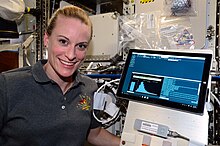
Human spaceflight is spaceflight with a crew or passengers aboard a spacecraft, often with the spacecraft being operated directly by the onboard human crew. Spacecraft can also be remotely operated from ground stations on Earth, or autonomously, without any direct human involvement. People trained for spaceflight are called astronauts, cosmonauts (Russian), or taikonauts (Chinese); and non-professionals are referred to as spaceflight participants or spacefarers.
Human spaceflight programs have been conducted, started, or planned by multiple countries and companies. Until the 21st century, human spaceflight programs were sponsored exclusively by governments, through either the military or civilian space agencies. With the launch of the privately funded SpaceShipOne in 2004, a new category of human spaceflight programs – commercial human spaceflight – arrived. As of July 2021, three countries and one private company (SpaceX) have launched humans to Earth orbit, and two private companies have launched humans on a suborbital trajectory. The criteria for what constitutes human spaceflight vary. The Fédération Aéronautique Internationale defines spaceflight as any flight over 100 kilometers (62 mi). In the United States professional, military, and commercial astronauts who travel above an altitude of 80 kilometers (50 mi) are awarded the United States Astronaut Badge. This article follows the FAI definition of spaceflight.

The Automated Transfer Vehicle, originally Ariane Transfer Vehicle or ATV, was an expendable cargo spacecraft developed by the European Space Agency (ESA), used for space cargo transport in 2008–2015. The ATV design was launched to orbit five times, exclusively by the Ariane 5 heavy-lift launch vehicle. It effectively was a larger European counterpart to the Russian Progress cargo spacecraft for carrying upmass to a single destination—the International Space Station (ISS)—but with three times the capacity.
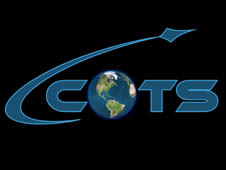
Commercial Orbital Transportation Services (COTS) was a NASA program to coordinate the development of vehicles for the delivery of crew and cargo to the International Space Station by private companies. The program was announced on January 18, 2006 and successfully flew all cargo demonstration flights by September 2013, when the program ended.

The Kistler K-1 was a two-stage, fully reusable launch vehicle design created by Kistler Aerospace. It was to accommodate a wide range of missions, including payload delivery to low Earth orbit (LEO), payload delivery to high-energy orbits with a K-1 Active Dispenser, technology demonstration flights, microgravity missions, and commercial cargo resupply, recovery, and reboost services for the International Space Station (ISS).
Andrews Space was founded in 1999 by Jason Andrews and Marian Joh to be a catalyst in the commercialization, exploration and development of space. Originally named Andrews Space & Technology, the company shortened its name in 2003 to Andrews Space. Over its life the company developed many unique technologies and space transportation architectures for the US Government and commercial customers. The company is now Spaceflight Systems, a subsidiary of Spaceflight Industries, Inc.

Cygnus is an expendable American cargo spacecraft developed by Orbital Sciences Corporation and now manufactured and launched by Northrop Grumman Space Systems as part of NASA's Commercial Resupply Services (CRS) program. It is launched by Northrop Grumman's Antares rocket or ULA's Atlas V and is designed to transport supplies to the International Space Station (ISS) following the retirement of the American Space Shuttle. Since August 2000, ISS resupply missions have been regularly flown by the Russian Progress spacecraft, as well as by the European Automated Transfer Vehicle, and the Japanese H-II Transfer Vehicle. With the Cygnus spacecraft and the SpaceX Dragon, NASA seeks to increase its partnerships with domestic commercial aviation and aeronautics industry.

Commercial Resupply Services (CRS) are a series of flights awarded by NASA for the delivery of cargo and supplies to the International Space Station (ISS) on commercially operated spacecraft. The first CRS contracts were signed in 2008 and awarded $1.6 billion to SpaceX for twelve cargo Dragon and $1.9 billion to Orbital Sciences for eight Cygnus flights, covering deliveries to 2016. The Falcon 9 and Antares rockets were also developed under the CRS program to deliver cargo spacecraft to the ISS.

Development of the Commercial Crew Program began in the second round of the Commercial Crew Development (CCDev) program, which was rescoped from a technology development program for human spaceflight to a competitive development program that would produce the spacecraft to be used in the Commercial Crew Program to provide crew transportation services to and from the International Space Station (ISS). To implement the program NASA awarded a series of competitive fixed-price contracts to private vendors starting in 2011. Operational contracts to fly astronauts were awarded in September 2014 to SpaceX and Boeing. Each company performed an uncrewed orbital test flight in 2019, and operational flights started in November 2020.

SpaceX CRS-2, also known as SpX-2, was the fourth flight for SpaceX's uncrewed Dragon cargo spacecraft, the fifth and final flight for the company's two-stage Falcon 9 v1.0 launch vehicle, and the second SpaceX operational mission contracted to NASA under a Commercial Resupply Services (CRS-1) contract.

SpaceX CRS-6, also known as SpX-6, was a Commercial Resupply Service mission to the International Space Station, contracted to NASA. It was the eighth flight for SpaceX's uncrewed Dragon cargo spacecraft and the sixth SpaceX operational mission contracted to NASA under a Commercial Resupply Services contract. It was docked to the International Space Station from 17 April to 21 May 2015.
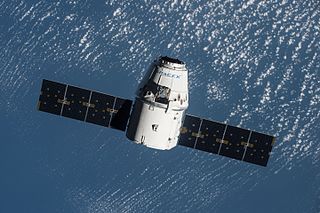
SpaceX CRS-9, also known as SpX-9, is a Commercial Resupply Service mission to the International Space Station which launched on 18 July 2016. The mission was contracted by NASA and is operated by SpaceX using a Dragon capsule.

SpaceX CRS-14, also known as SpX-14, was a Commercial Resupply Service mission to the International Space Station launched on 2 April 2018. The mission was contracted by NASA and was flown by SpaceX. This mission reused the Falcon 9 first stage booster previously flown on CRS-12 and the Dragon capsule flown on CRS-8.

SpaceX CRS-18, also known as SpX-18, was SpaceX's 18th flight to the International Space Station under the Commercial Resupply Services program for NASA. It was launched on 25 July 2019 aboard a Falcon 9 rocket.
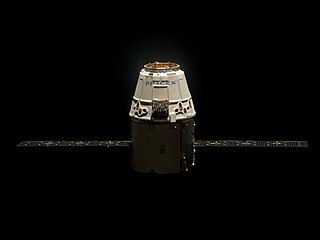
Dragon, also known as Dragon 1 or Cargo Dragon, was a class of fourteen partially reusable cargo spacecraft developed by SpaceX, an American private space transportation company. The spacecraft flew 23 missions between 2010 and 2020. Dragon was launched into orbit by the company's Falcon 9 launch vehicle to resupply the International Space Station (ISS).

SpaceX CRS-21, also known as SpX-21, was a Commercial Resupply Service mission to the International Space Station which launched on 6 December 2020. The mission was contracted by NASA and was flown by SpaceX using a Cargo Dragon 2. This was the first flight for SpaceX under NASA's CRS Phase 2 contract awarded in January 2016. This was also the first Cargo Dragon of the new Dragon 2 variant, as well as the first Cargo Dragon flight that was docked at the same time as a Crew Dragon spacecraft. This mission used Booster B1058.4, becoming the first NASA mission to reuse a booster previously used on a non-NASA mission. This was also first time SpaceX launched a NASA payload on a booster with more than one previous flight.
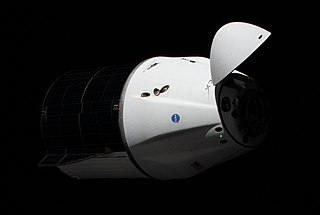
SpaceX CRS-22, also known as SpX-22, was a Commercial Resupply Services (CRS) mission to the International Space Station (ISS) that launched at 17:29:15 UTC on 3 June 2021. The mission is contracted by NASA and is flown by SpaceX using a Cargo Dragon 2. This is the second flight for SpaceX under NASA's CRS Phase 2 contract awarded in January 2016.

NG-18 is the eighteenth flight of the Northrop Grumman robotic resupply spacecraft Cygnus and its sixteenth flight to the International Space Station (ISS) under the Commercial Resupply Services (CRS-2) contract with NASA. The mission successfully launched on 7 November 2022. This is the seventh launch of Cygnus under the CRS-2 contract.

SpaceX CRS-26, also known as SpX-26, is a Commercial Resupply Service mission to the International Space Station (ISS) launched on 26 November 2022. The mission is contracted by NASA and is flown by SpaceX using a Cargo Dragon. This is the sixth flight for SpaceX under NASA's CRS Phase 2 contract awarded in January 2016.




